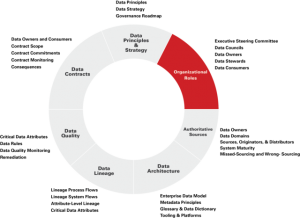The data governance road map should define a data governance operating model and organization structure. As part of the structure, an executive steering committee should be established with representation from all key areas of the financial institution.
The steering committee is responsible for providing overall direction and vision for the company’s data strategy and governance and should define key roles for effectively managing data across the company. While the roles may vary from company to company, some of the key roles include data councils, data owners, data stewards, and data consumers.
First, data councils should be established for each business line (wealth management, trading, investment banking) and key functional area (finance, treasury, risk, reference data). Data councils have business and technology accountability and identify responsibilities for data ownership and data stewardship.
The data owners understand the business, define the data and critical attributes, and are responsible for the data quality delivered to downstream data consumers. Data stewards provide support to the data councils and data owners and are responsible for fixing, mitigating, and maintaining the quality of data within their business units.
The data councils will be responsible for confirming authoritative sources, ensuring sustainable data lineage and executing data contracts between data owners and consumers.
We recently published a guide that explores the building blocks (i.e., data governance components) of data governance, which can help drive better business decisions, enhance regulatory compliance, and improve risk management. You can download it here.


